seats SATURN VUE 2008 User Guide
[x] Cancel search | Manufacturer: SATURN, Model Year: 2008, Model line: VUE, Model: SATURN VUE 2008Pages: 412, PDF Size: 2.78 MB
Page 34 of 412
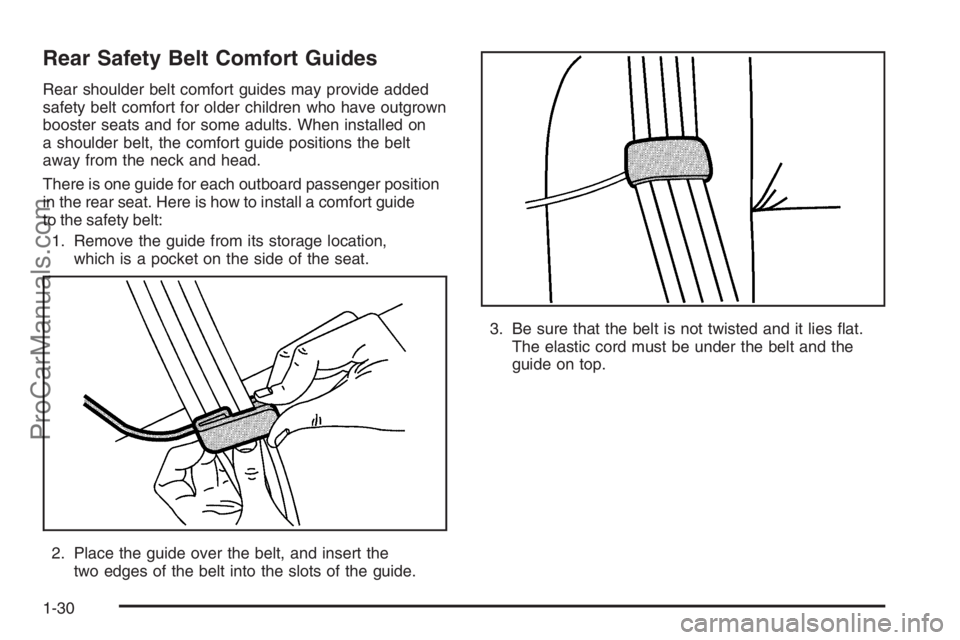
Rear Safety Belt Comfort Guides
Rear shoulder belt comfort guides may provide added
safety belt comfort for older children who have outgrown
booster seats and for some adults. When installed on
a shoulder belt, the comfort guide positions the belt
away from the neck and head.
There is one guide for each outboard passenger position
in the rear seat. Here is how to install a comfort guide
to the safety belt:
1. Remove the guide from its storage location,
which is a pocket on the side of the seat.
2. Place the guide over the belt, and insert the
two edges of the belt into the slots of the guide.3. Be sure that the belt is not twisted and it lies �at.
The elastic cord must be under the belt and the
guide on top.
1-30
ProCarManuals.com
Page 36 of 412
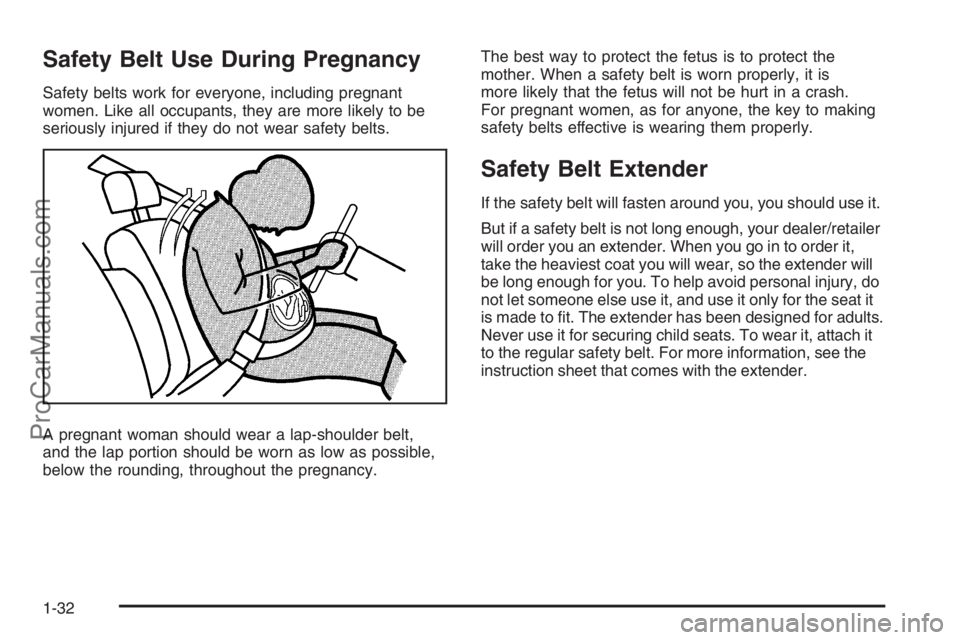
Safety Belt Use During Pregnancy
Safety belts work for everyone, including pregnant
women. Like all occupants, they are more likely to be
seriously injured if they do not wear safety belts.
A pregnant woman should wear a lap-shoulder belt,
and the lap portion should be worn as low as possible,
below the rounding, throughout the pregnancy.The best way to protect the fetus is to protect the
mother. When a safety belt is worn properly, it is
more likely that the fetus will not be hurt in a crash.
For pregnant women, as for anyone, the key to making
safety belts effective is wearing them properly.
Safety Belt Extender
If the safety belt will fasten around you, you should use it.
But if a safety belt is not long enough, your dealer/retailer
will order you an extender. When you go in to order it,
take the heaviest coat you will wear, so the extender will
be long enough for you. To help avoid personal injury, do
not let someone else use it, and use it only for the seat it
is made to �t. The extender has been designed for adults.
Never use it for securing child seats. To wear it, attach it
to the regular safety belt. For more information, see the
instruction sheet that comes with the extender.
1-32
ProCarManuals.com
Page 37 of 412
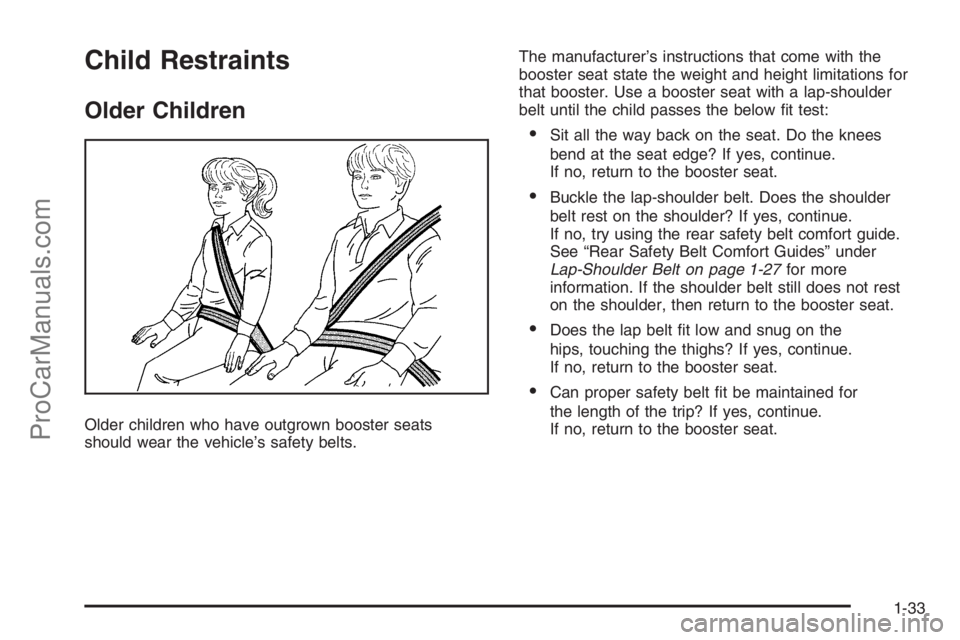
Child Restraints
Older Children
Older children who have outgrown booster seats
should wear the vehicle’s safety belts.The manufacturer’s instructions that come with the
booster seat state the weight and height limitations for
that booster. Use a booster seat with a lap-shoulder
belt until the child passes the below �t test:
Sit all the way back on the seat. Do the knees
bend at the seat edge? If yes, continue.
If no, return to the booster seat.
Buckle the lap-shoulder belt. Does the shoulder
belt rest on the shoulder? If yes, continue.
If no, try using the rear safety belt comfort guide.
See “Rear Safety Belt Comfort Guides” under
Lap-Shoulder Belt on page 1-27for more
information. If the shoulder belt still does not rest
on the shoulder, then return to the booster seat.
Does the lap belt �t low and snug on the
hips, touching the thighs? If yes, continue.
If no, return to the booster seat.
Can proper safety belt �t be maintained for
the length of the trip? If yes, continue.
If no, return to the booster seat.
1-33
ProCarManuals.com
Page 45 of 412

To help reduce the chance of injury, the child restraint
must be secured in the vehicle. Child restraint systems
must be secured in vehicle seats by lap belts or
the lap belt portion of a lap-shoulder belt, or by the
LATCH system. SeeLower Anchors and Tethers
for Children (LATCH) on page 1-43for more information.
A child can be endangered in a crash if the child
restraint is not properly secured in the vehicle.
When securing an add-on child restraint, refer to the
instructions that come with the restraint which may be
on the restraint itself or in a booklet, or both, and to this
manual. The child restraint instructions are important,
so if they are not available, obtain a replacement
copy from the manufacturer.
Keep in mind that an unsecured child restraint can
move around in a collision or sudden stop and injure
people in the vehicle. Be sure to properly secure
any child restraint in your vehicle — even when
no child is in it.Securing the Child Within the
Child Restraint
{CAUTION:
A child can be seriously injured or killed in a
crash if the child is not properly secured in
the child restraint. Because there are different
systems, it is important to refer to the
instructions that come with the restraint. Make
sure the child is properly secured, following
the instructions that came with that restraint.
Where to Put the Restraint
Accident statistics show that children are safer if they
are restrained in the rear rather than the front seat.
We recommend that children and child restraints
be secured in a rear seat, including: an infant or a child
riding in a rear-facing child restraint; a child riding in
a forward-facing child seat; an older child riding in
a booster seat; and children, who are large enough,
using safety belts.
1-41
ProCarManuals.com
Page 74 of 412

Servicing Your Airbag-Equipped
Vehicle
Airbags affect how your vehicle should be serviced.
There are parts of the airbag system in several places
around your vehicle. Your dealer/retailer and the service
manual have information about servicing your vehicle and
the airbag system. To purchase a service manual, see
Service Publications Ordering Information on page 7-15.
{CAUTION:
For up to 10 seconds after the ignition is turned
off and the battery is disconnected, an airbag
can still in�ate during improper service. You
can be injured if you are close to an airbag when
it in�ates. Avoid yellow connectors. They are
probably part of the airbag system. Be sure to
follow proper service procedures, and make
sure the person performing work for you is
quali�ed to do so.
Adding Equipment to Your
Airbag-Equipped Vehicle
Q:Is there anything I might add to or change
about the vehicle that could keep the airbags
from working properly?
A:Yes. If you add things that change your vehicle’s
frame, bumper system, height, front end or side
sheet metal, they may keep the airbag system from
working properly. Changing or moving any parts
of the front seats, safety belts, the airbag sensing
and diagnostic module, steering wheel, instrument
panel, roof-rail airbag modules, ceiling headliner
or pillar garnish trim, front sensors, side impact
sensors, rollover sensor module, or airbag wiring
can affect the operation of the airbag system.
1-70
ProCarManuals.com
Page 100 of 412
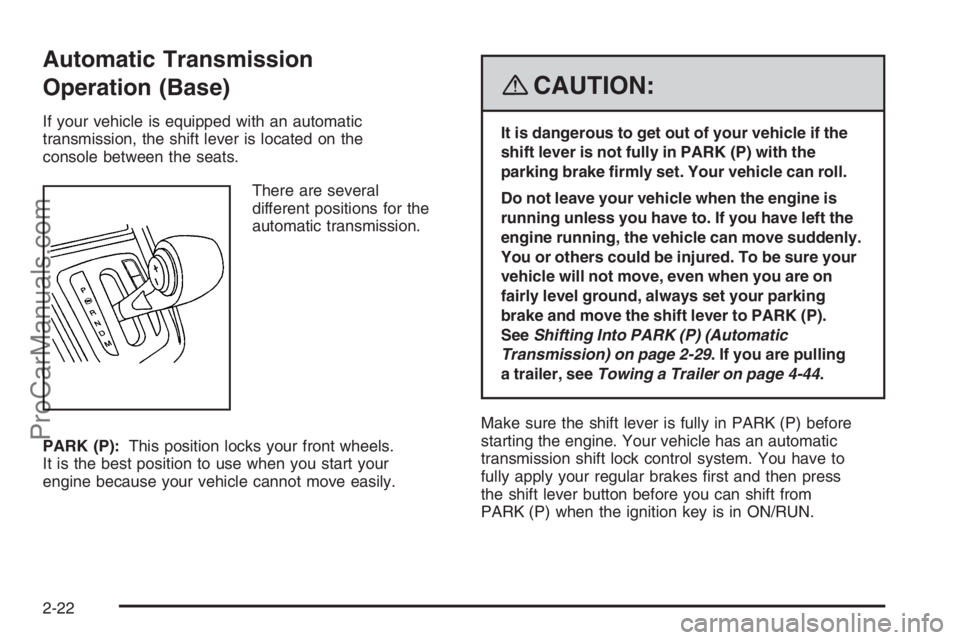
Automatic Transmission
Operation (Base)
If your vehicle is equipped with an automatic
transmission, the shift lever is located on the
console between the seats.
There are several
different positions for the
automatic transmission.
PARK (P):This position locks your front wheels.
It is the best position to use when you start your
engine because your vehicle cannot move easily.
{CAUTION:
It is dangerous to get out of your vehicle if the
shift lever is not fully in PARK (P) with the
parking brake �rmly set. Your vehicle can roll.
Do not leave your vehicle when the engine is
running unless you have to. If you have left the
engine running, the vehicle can move suddenly.
You or others could be injured. To be sure your
vehicle will not move, even when you are on
fairly level ground, always set your parking
brake and move the shift lever to PARK (P).
SeeShifting Into PARK (P) (Automatic
Transmission) on page 2-29. If you are pulling
a trailer, seeTowing a Trailer on page 4-44.
Make sure the shift lever is fully in PARK (P) before
starting the engine. Your vehicle has an automatic
transmission shift lock control system. You have to
fully apply your regular brakes �rst and then press
the shift lever button before you can shift from
PARK (P) when the ignition key is in ON/RUN.
2-22
ProCarManuals.com
Page 103 of 412
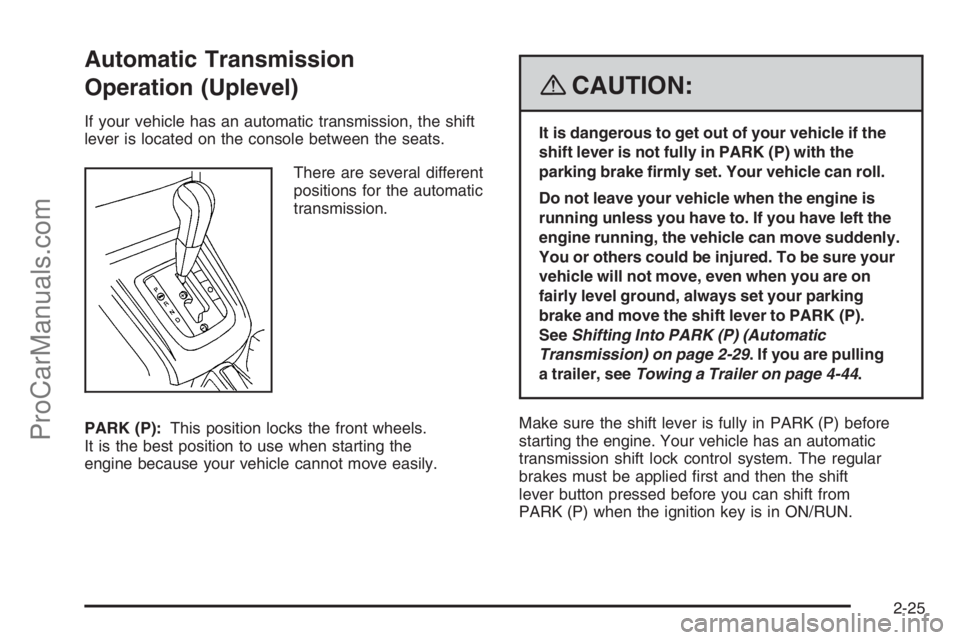
Automatic Transmission
Operation (Uplevel)
If your vehicle has an automatic transmission, the shift
lever is located on the console between the seats.
There are several different
positions for the automatic
transmission.
PARK (P):This position locks the front wheels.
It is the best position to use when starting the
engine because your vehicle cannot move easily.
{CAUTION:
It is dangerous to get out of your vehicle if the
shift lever is not fully in PARK (P) with the
parking brake �rmly set. Your vehicle can roll.
Do not leave your vehicle when the engine is
running unless you have to. If you have left the
engine running, the vehicle can move suddenly.
You or others could be injured. To be sure your
vehicle will not move, even when you are on
fairly level ground, always set your parking
brake and move the shift lever to PARK (P).
SeeShifting Into PARK (P) (Automatic
Transmission) on page 2-29. If you are pulling
a trailer, seeTowing a Trailer on page 4-44.
Make sure the shift lever is fully in PARK (P) before
starting the engine. Your vehicle has an automatic
transmission shift lock control system. The regular
brakes must be applied �rst and then the shift
lever button pressed before you can shift from
PARK (P) when the ignition key is in ON/RUN.
2-25
ProCarManuals.com
Page 156 of 412
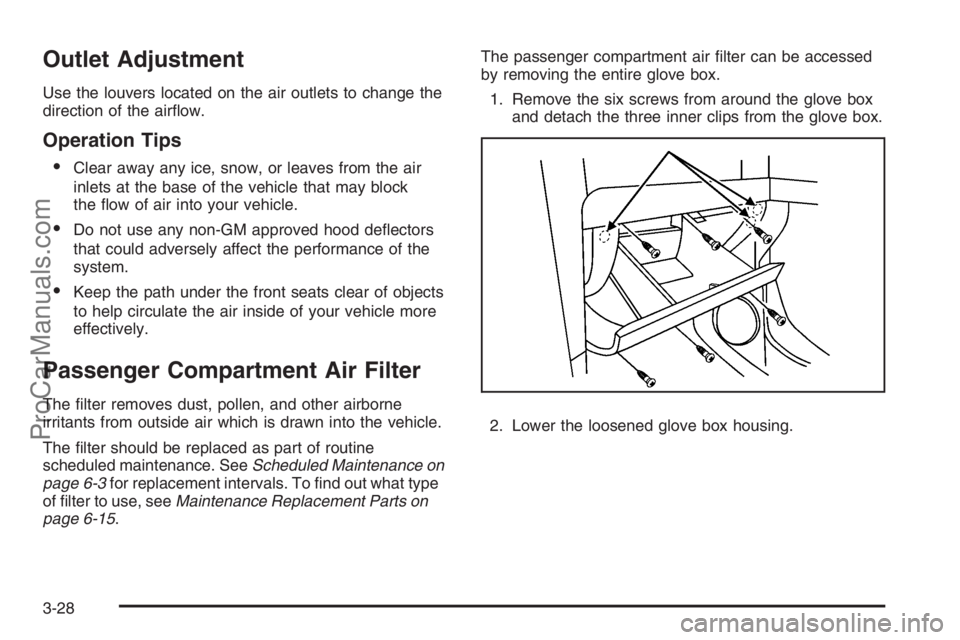
Outlet Adjustment
Use the louvers located on the air outlets to change the
direction of the air�ow.
Operation Tips
Clear away any ice, snow, or leaves from the air
inlets at the base of the vehicle that may block
the �ow of air into your vehicle.
Do not use any non-GM approved hood de�ectors
that could adversely affect the performance of the
system.
Keep the path under the front seats clear of objects
to help circulate the air inside of your vehicle more
effectively.
Passenger Compartment Air Filter
The �lter removes dust, pollen, and other airborne
irritants from outside air which is drawn into the vehicle.
The �lter should be replaced as part of routine
scheduled maintenance. SeeScheduled Maintenance on
page 6-3for replacement intervals. To �nd out what type
of �lter to use, seeMaintenance Replacement Parts on
page 6-15.The passenger compartment air �lter can be accessed
by removing the entire glove box.
1. Remove the six screws from around the glove box
and detach the three inner clips from the glove box.
2. Lower the loosened glove box housing.
3-28
ProCarManuals.com
Page 179 of 412
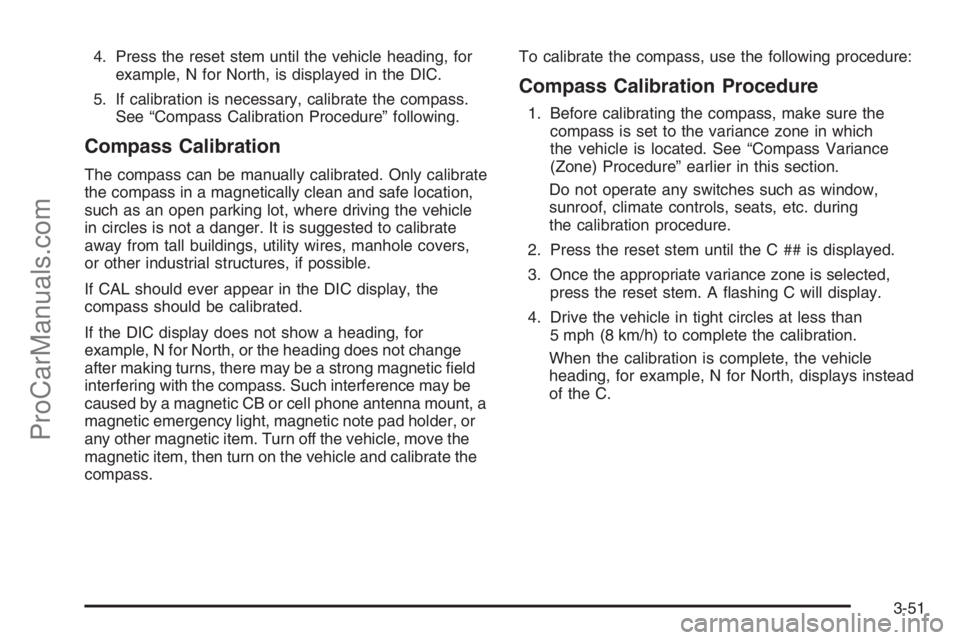
4. Press the reset stem until the vehicle heading, for
example, N for North, is displayed in the DIC.
5. If calibration is necessary, calibrate the compass.
See “Compass Calibration Procedure” following.
Compass Calibration
The compass can be manually calibrated. Only calibrate
the compass in a magnetically clean and safe location,
such as an open parking lot, where driving the vehicle
in circles is not a danger. It is suggested to calibrate
away from tall buildings, utility wires, manhole covers,
or other industrial structures, if possible.
If CAL should ever appear in the DIC display, the
compass should be calibrated.
If the DIC display does not show a heading, for
example, N for North, or the heading does not change
after making turns, there may be a strong magnetic �eld
interfering with the compass. Such interference may be
caused by a magnetic CB or cell phone antenna mount, a
magnetic emergency light, magnetic note pad holder, or
any other magnetic item. Turn off the vehicle, move the
magnetic item, then turn on the vehicle and calibrate the
compass.To calibrate the compass, use the following procedure:
Compass Calibration Procedure
1. Before calibrating the compass, make sure the
compass is set to the variance zone in which
the vehicle is located. See “Compass Variance
(Zone) Procedure” earlier in this section.
Do not operate any switches such as window,
sunroof, climate controls, seats, etc. during
the calibration procedure.
2. Press the reset stem until the C ## is displayed.
3. Once the appropriate variance zone is selected,
press the reset stem. A �ashing C will display.
4. Drive the vehicle in tight circles at less than
5 mph (8 km/h) to complete the calibration.
When the calibration is complete, the vehicle
heading, for example, N for North, displays instead
of the C.
3-51
ProCarManuals.com
Page 240 of 412

Similar looking vehicles may have different
GVWRs and payloads. Please consult your
vehicle’s Certi�cation/Tire label or your retailer
for additional details.
{CAUTION:
Do not load the vehicle any heavier than
the Gross Vehicle Weight Rating (GVWR),
or either the maximum front or rear Gross
Axle Weight Rating (GAWR). If you do,
parts on the vehicle can break, and it can
change the way your vehicle handles.
These could cause you to lose control
and crash. Also, overloading can shorten
the life of the vehicle.
Using heavier suspension components to get
added durability might not change your vehicle’s
weight ratings. Ask your dealer/retailer to help you
load your vehicle correctly if you are using these
components.
Notice:Overloading your vehicle may cause
damage. Repairs would not be covered by your
warranty. Do not overload your vehicle.If you put things inside your vehicle — like
suitcases, tools, packages, or anything
else — they will go as fast as the vehicle goes.
If you have to stop or turn quickly, or if there is a
crash, they will keep going.
{CAUTION:
Things you put inside your vehicle can
strike and injure people in a sudden stop
or turn, or in a crash.
Put things in the cargo area of your
vehicle. Try to spread the weight
evenly.
Never stack heavier things, like
suitcases, inside the vehicle so that
some of them are above the tops of
the seats.
Do not leave an unsecured child
restraint in your vehicle.
When you carry something inside the
vehicle, secure it whenever you can.
Do not leave a seat folded down
unless you need to.
4-40
ProCarManuals.com